23R1 Patient Care Journey App Release
Patient Care Journey App
New Features
- Login: Single Sign-On (SSO)
- Navigation Menu: Medical Profile
- Appointments: Check-in Process
- Notifications: In-App Homepage Reminders
- Notifications: To Do List
- Appointments: Calendar Integration, Calendar Reminders
- Care History: Timeline View
- Visit Summary: Documents
- Visit Summary: Lab Data Visualization
Enhancements
- Care History: Imaging Reports, Test Analyte Notes
- Notifications: Read and Unread Actions (iOS Only)
- Onboarding: HIPPA Consent Representative
- Visit Summary: Appointment Provider
Unless otherwise indicated:
All features are available for the Tendo app and Tendo for iOS.
Features are enabled on an individual per-system basis. Healthcare institutions must contact Tendo for enablement and configuration.
Information about fixed bugs for this release can be viewed in the Tendo changelogs.
New Features
Login: Single Sign-On (SSO)
Patients who have a login to their provider’s health care system may not want to manage multiple logins for healthcare sites. New functionality allows patients to decide whether to authenticate with their health system or directly with Tendo through Single Sign-On (SSO). This option allows patients to have an improved user experience by only needing a single set of login credentials.
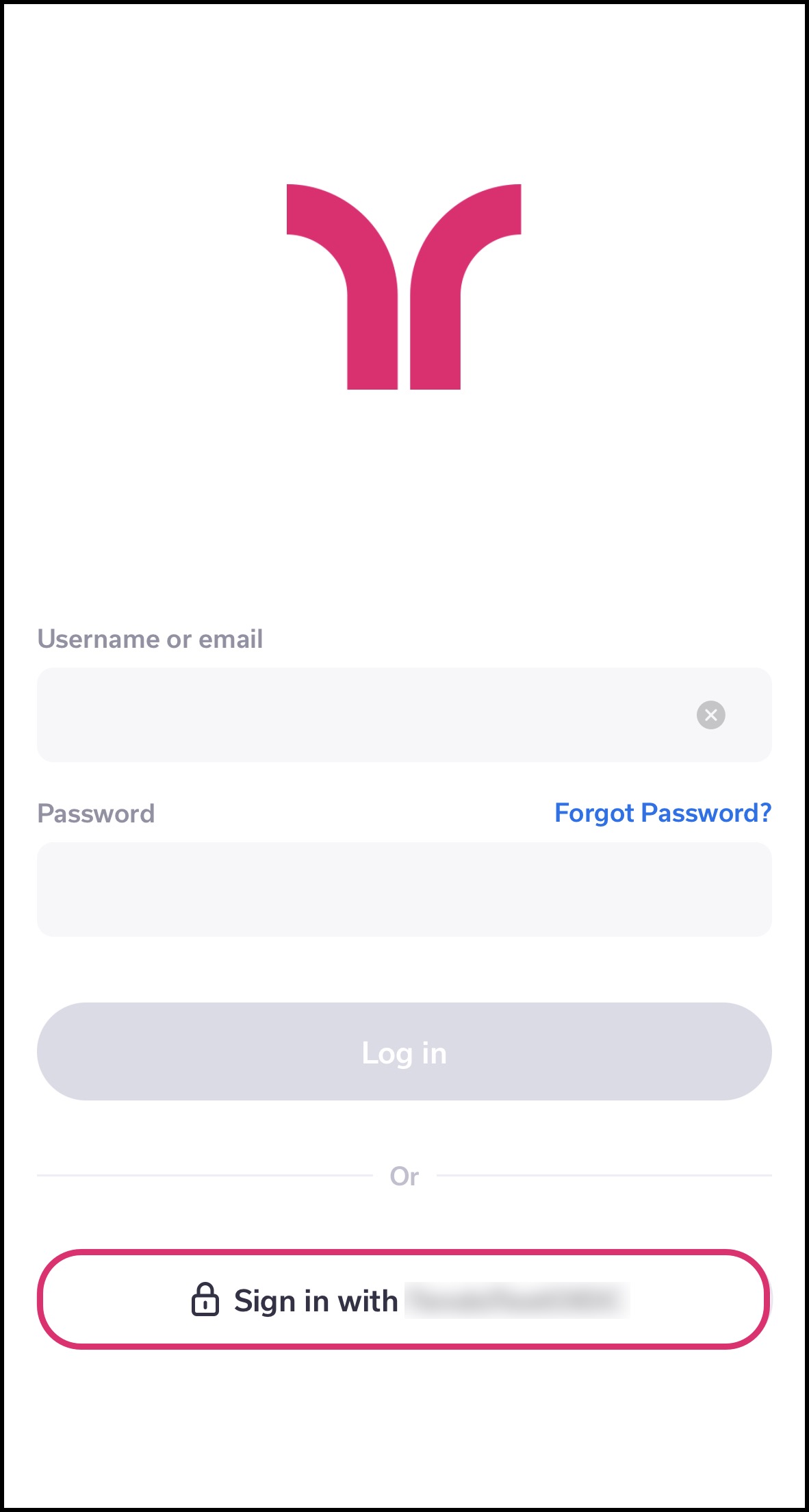
How it Works
Tendo uses authentication with currently supported healthcare systems so patients only require one login to access their Tendo account. Both OIDC and SAML authentication methods are supported.
To initially link accounts, the email address used for both the healthcare system and the Tendo account must match. When the Tendo app authentication session has expired, patients who have logged in via SSO either through their healthcare system of Tendo will be redirected back to the Tendo login page. They can repeat the login process to reauthenticate and log in again.
Workflows
Healthcare System
When a patient logs in to their healthcare system that has enabled SSO with Tendo, they can view an option to access Tendo and are automatically redirected and logged into Tendo.
Tendo App
After entering their username/email address in either Tendo or the Tendo iOS app, patients whose healthcare systems have enabled SSO view a new login option. If they select the option to use SSO, they are redirected to their healthcare system. If the patient is logged into their healthcare system, they are automatically redirected into the app. However, if the patient has not already logged in, the patient will enter their health care system credentials and then be redirected into the Tendo app.
Supporting Documentation
Platform Availability: 2023-02-15 | iOS 2023.6.0
Navigation Menu: Medical Profile
Patients want to feel ownership over their health records. Being able to view their medical history is important in their care journey.
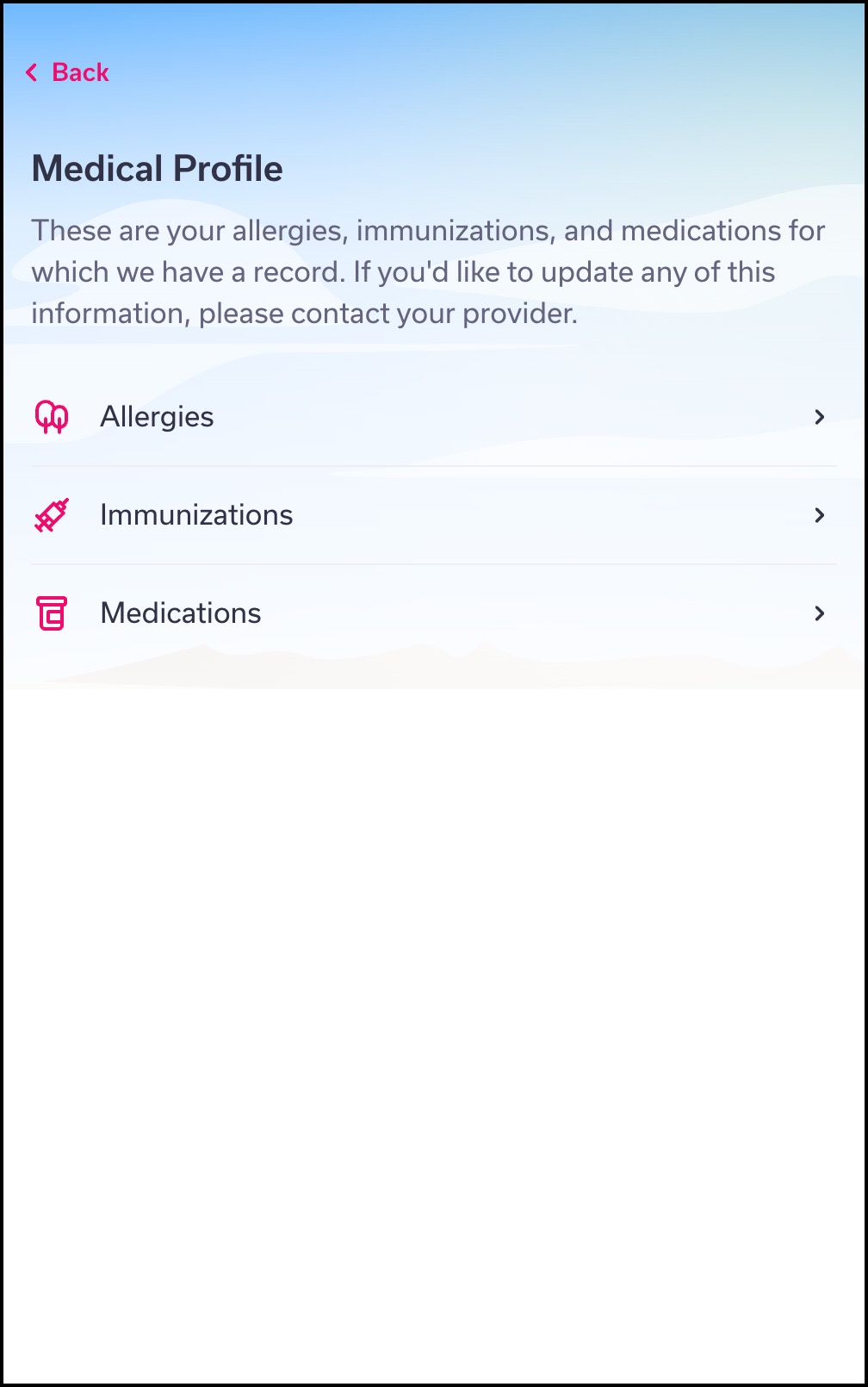
How it Works
A patient’s medical information is pulled from the patient’s healthcare system and stored in Tendo.
Workflows
A patient can open the User Navigation Menu and access the Medical Profile link. Medical profile information from the patient’s healthcare system displays in the Tendo app. Changes can be made to the medical profile by a provider or staff member during a patient’s appointment.
Supporting Documentation
Platform Availability: 2023-02-15 | iOS 2023.6.0
Appointments: Check-in Process
Providers need to obtain consent forms, questionnaires, and other patient intake data before an appointment begins. Both patients and providers want to maximize their time during an appointment and look to complete any requirements before the appointment begins.
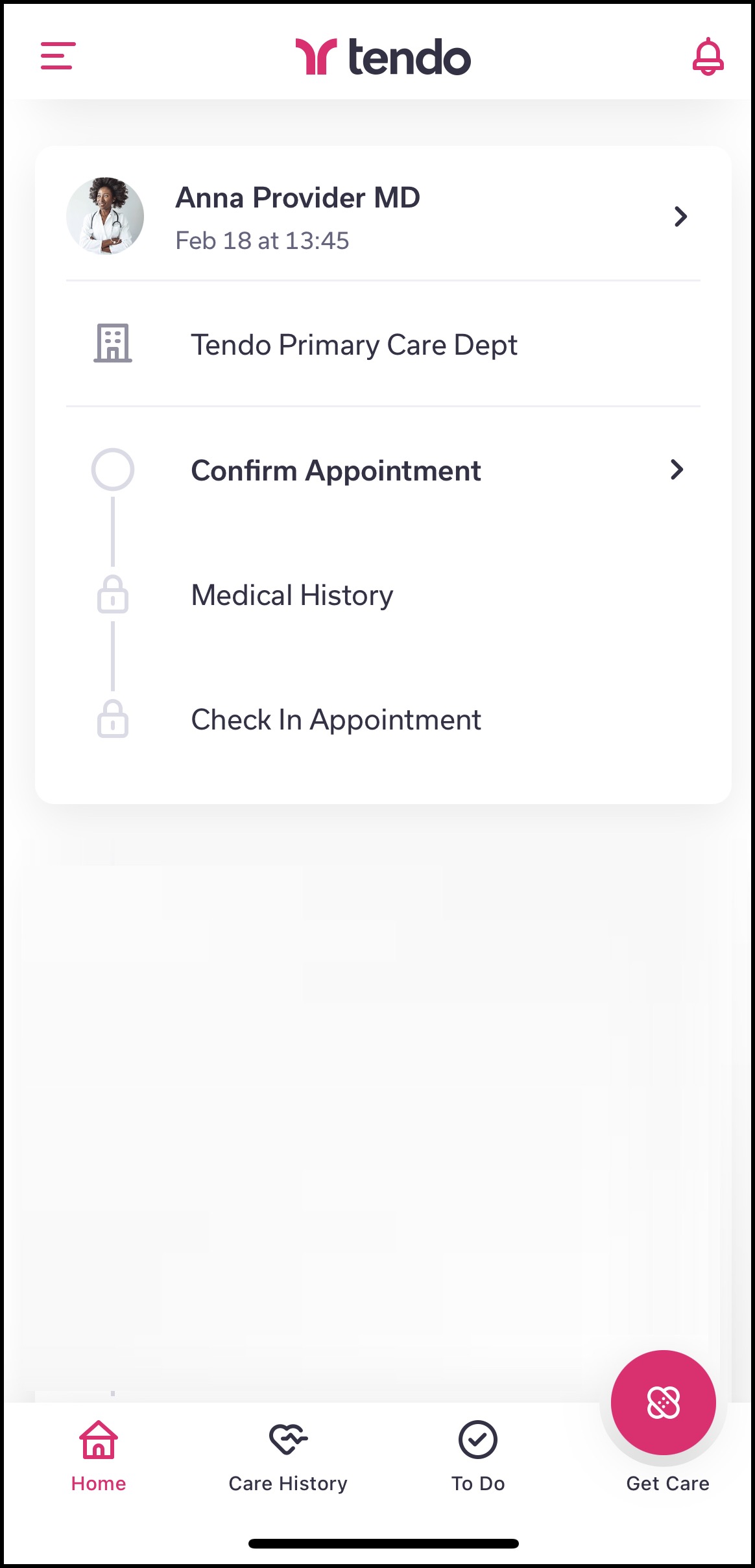
How it Works
In addition to confirming an appointment, providers can choose to include consent forms, questionnaires, e-signatures, and other patient intake data as part of the check-in process. Forms can be customized to capture and retain specific medical, social, surgical, and family history information. This information is stored in the Tendo database and passed back to the provider.
Workflows
When checking into an appointment, patients view and verify their history through an electronic medical form. For future check-ins, Tendo prefills patients’ electronic medical forms with information from previous submissions, and patients only need to modify relevant information that may have changed.
Supporting Documentation
Platform Availability: 2023-02-15 | iOS 2023.6.0
Notifications: In-App Homepage Reminders
Tendo’s notifications keep patients focused on follow-up reminders. Patients are notified when aspects of their care are available from a previous visit, or when patients need to take some sort of action for their health.
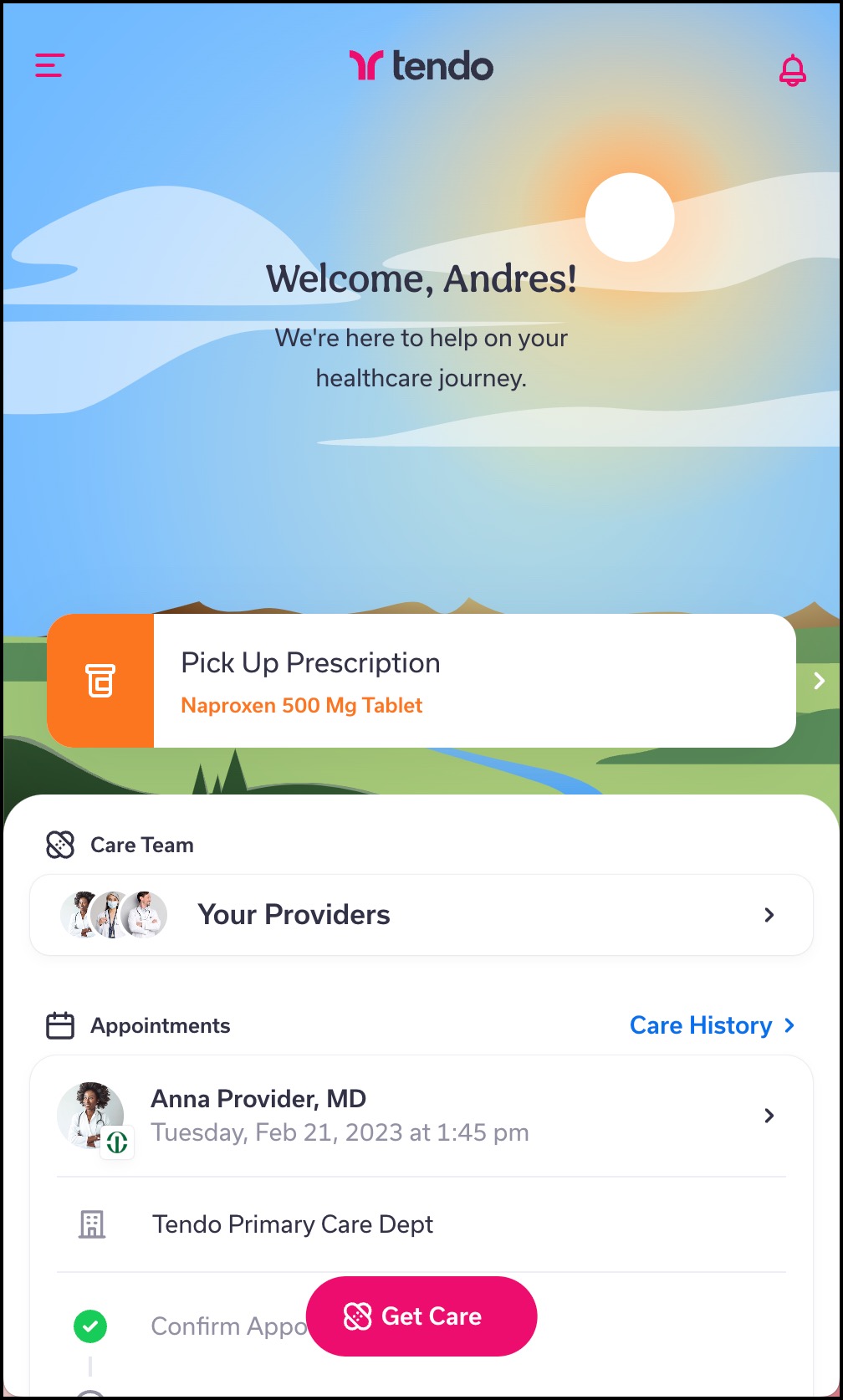
How it Works
Notifications display in the home page of the Tendo app. Tapping a notification directs the patient to the relevant page for the notification. Up to three notifications are displayed at a time.
Workflows
Appointments
A patient receives a notification to schedule an appointment for a referral. Tapping the notification takes them directly to the referral page with the referral’s phone number.
Orders
A patient receives a notification to complete specific lab work. Tapping the notification takes them directly to the order page with the lab information and location.
Resources
A patient receives a notification that a new resource is available from a previous appointment. Tapping the notification takes them directly to the resource.
Prescriptions
A patient receives a notification that a prescription is available for pickup. Tapping the notification takes them directly to the prescription page to view the location where the prescription has been sent.
Note: The notification does not indicate the real-time status of the prescription; the patient can call the pharmacy to confirm if needed.
Visit Summary
A patient receives a notification that a visit summary is available from a previous appointment. Tapping the notification takes them directly to the Visit Summary page.
Supporting Documentation
Platform Availability: 2023-02-15 | iOS 2023.6.0
Notifications: To Do List
If configured by a provider, in-app notifications may direct to To Do items.
The To Do list provides a step-by-step process to help patients manage all tasks along their healthcare journey, both before and after an appointment. Most commonly, an appointment may include items such as scheduling a test, picking up a prescription, requesting a referral appointment, or other type of action.
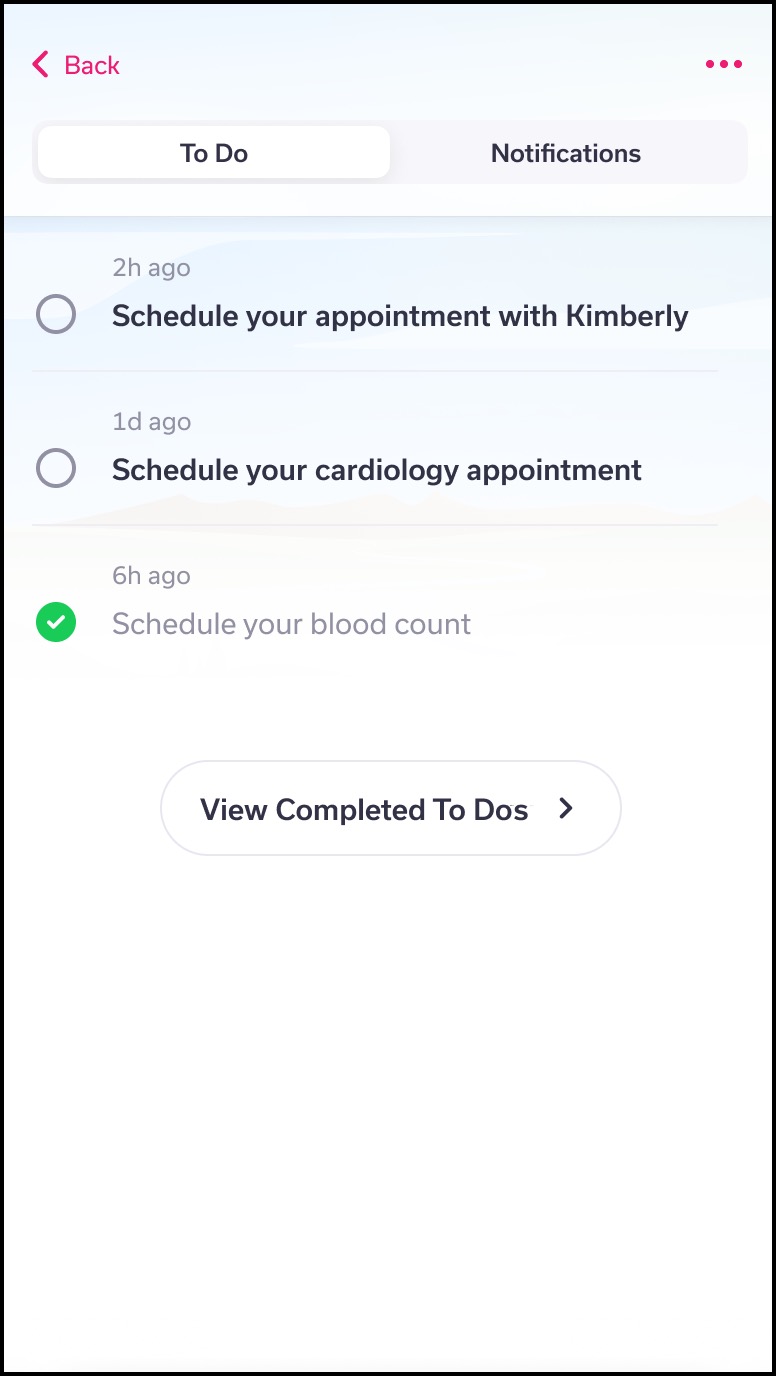
How it Works
To Do items are generated from a patient’s health profile and visit summaries. When a new To Do item is added for a patient, a notification is generated in the app. The item remains in the page until it is manually checked off by the patient, either in the To Do list or in the specific To Do item.
Workflows
Appointments
A patient’s To Do list includes an item to schedule an appointment for a referral. Tapping the item opens to the referral page. If the referral can be scheduled via Tendo, the patient can schedule an online appointment. However, if online scheduling is not available, the patient can call the referral office. After scheduling the appointment, the patient can manually mark the item as completed.
Orders
A patient’s To Do list includes an item to complete a specific lab test. Tapping the item opens to the test information. After completing the test work at the designated location, the patient can mark the item as completed.
Prescriptions
A patient’s To Do list includes an item to pick up a prescription. Tapping the item opens to the prescription information. After picking up the prescription at the designated location, the patient can mark the item as completed.
Resources
A patient’s To Do list includes an item to view a resource. Tapping the item opens to the resource; after reviewing the resource, the patient can manually mark the item as completed.
Supporting Documentation
Platform Availability: 2023-02-15 | iOS 2023.6.0
Appointments: Calendar Integration
Appointments can be added to a patient's electronic calendar. This change allows patients to integrate appointment dates as calendar events that display in the calendar provider of their choice. Supported calendar integrations include Google, Apple, iCal, Microsoft 365, Outlook.com, and Yahoo.


How it Works
For each appointment, the appointment details page includes a calendar ICS file format that is supported in both web and iOS platforms. Supported calendar apps include Google Calendar, Microsoft Outlook, and Apple iCalendar. Details of the appointment are included in the ICS file including appointment name, date, time, and location.
Workflow
When a patient schedules an appointment, the appointment details page includes a Add to Calendar button. An appointment can be added to an electronic calendar after creating a new appointment or when viewing an upcoming appointment.
Supporting Documentation
Platform Availability: 2022-11-11, iOS 2023.6.0
Appointments: Calendar Reminders
After an appointment is scheduled, patients want to be able to add calendar appointments to their electronic devices. This action helps them plan their appointment among all other reminders they have scheduled.
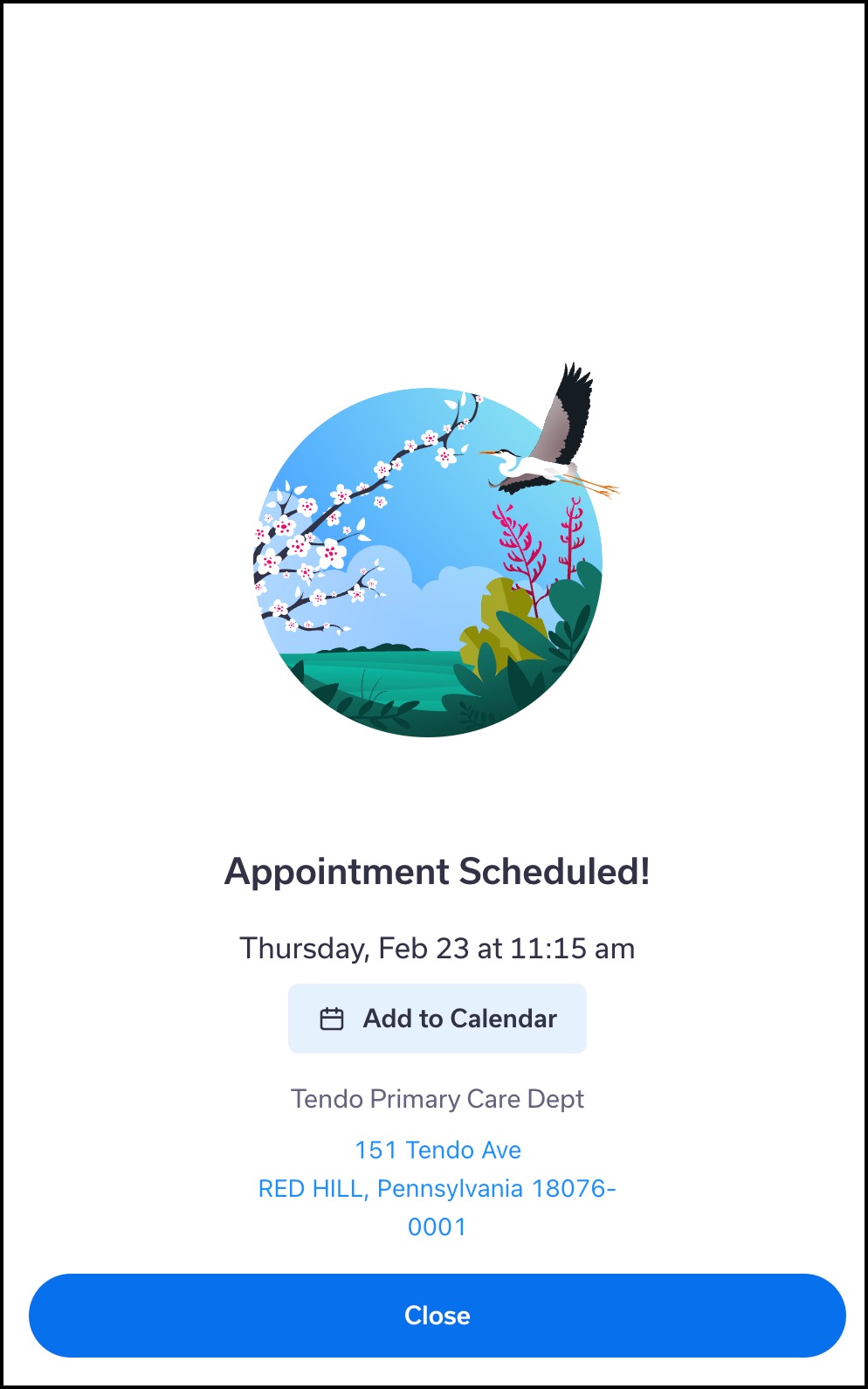
How it Works
For each appointment, the appointment details page includes a calendar ICS file format that is supported in both web and iOS platforms. Supported calendar apps include Google Calendar, Microsoft Outlook, and Apple iCalendar. Details of the appointment are included in the ICS file including appointment name, date, time, and location.
Workflow
When a patient schedules an appointment, the appointment details page prompts the patient to add the appointment to their calendar. Tapping the Add Event button initiates the calendar process. On iOS devices, the appointment is always added to the calendar assigned as the default.
Supporting Documentation
Platform Availability: 2022-11-11, iOS 2023.6.0
Care History: Timeline View
Care history cards display in a timeline format. Additionally, Care History items can be filtered by type. These changes reduce cognitive load and recall within this page.
Care History results are ordered by date. Each entry within the date displays additional resource information:
Visit Summaries indicate the reason for a visit.
Resources, prescriptions, and other resource documents indicate the order date.
Labs and image tests display the date of the order; once results are received, the test displays the results date.

Pagination is adjusted automatically as you scroll down the page. When no more results are available, the page displays a note indicating you have reached the end of your health data list.
The Filter can still be used to simplify all entries in the Care History and help you focus on a specific type of prior care.
Supporting Documentation
Platform Availability: 2022-11-17 | iOS 2022.47.0
Visit Summary: Documents
Patients often need to request letters and other documents from their providers, such as a letter to return to work or return to play in a sports team. These letters can be requested during a phone call, patient portal message, or during a provider visit. Tendo provides functionality for patients to access letters from their providers when available.
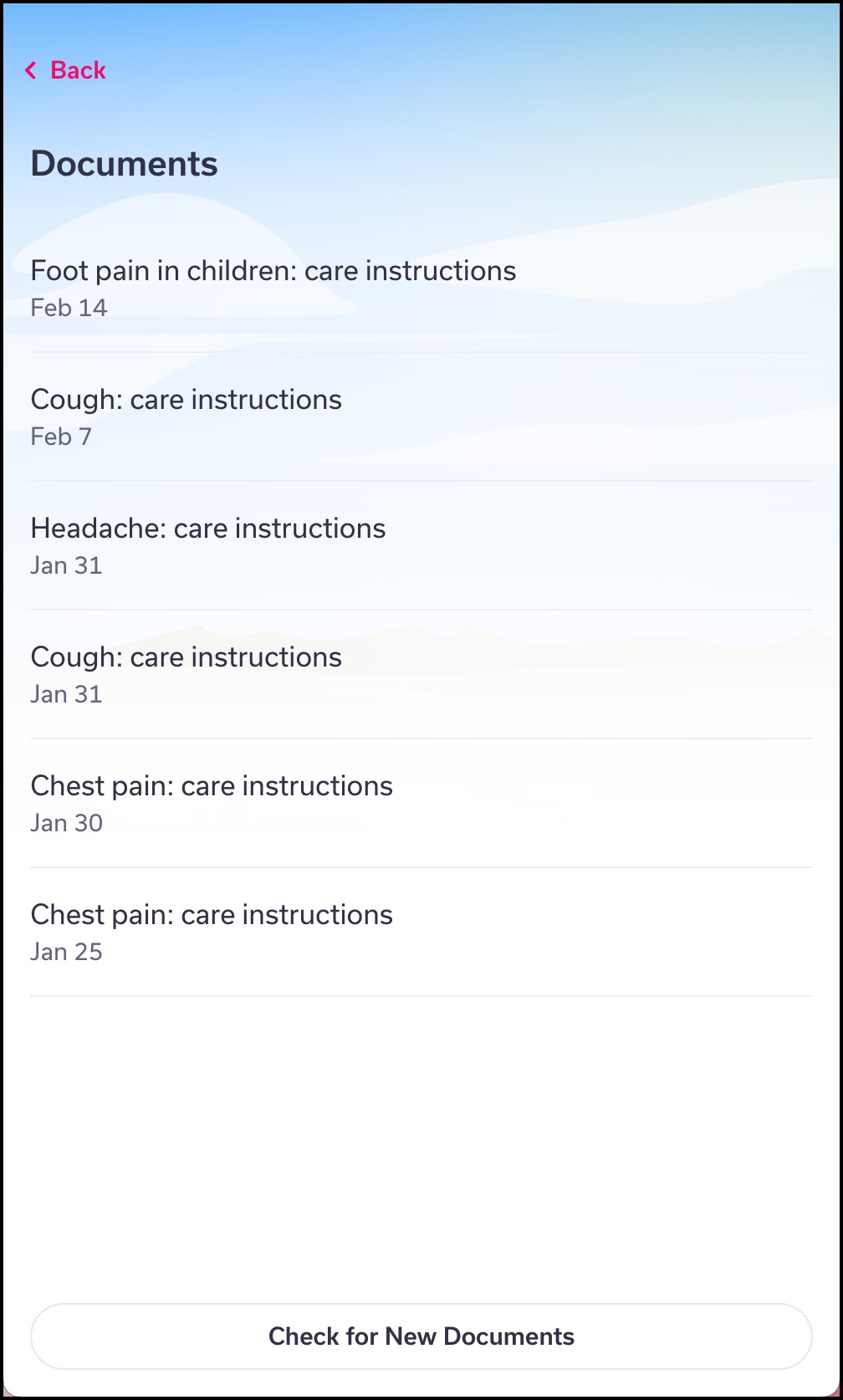
How it Works
Documents from a provider are stored in the patient’s healthcare system. Tendo allows patients to check to see if a new document or letter has been posted by their provider. If a document is available, the document displays in the Tendo app. Once a document has been returned, the document displays both in the Documents page and in the Care History, which can be filtered to view documents only.
Additionally, if the document is associated with an appointment, the document will display as part of the Visit Summary.
Workflows
When a patient receives a notification that their visit summary is available, they can also view if the summary includes a link to a document or letter. The document can be viewed and printed from a browser window.
Supporting Documentation
Platform Availability: 2023-02-15 | iOS 2023.6.0
Visit Summary: Lab Data Visualization
Patients want to be able to clearly understand their lab results. Lab results consist of analytes, which are the specific components being analyzed in the lab. Some results may encompass a range that include upper and/or lower limits of a lab test.
When results include range-based analytes, the range must be defined to help patients know when their results may fall outside the range. Additionally, providers can also add notes that accompany each analyte and help patients know how to best proceed with their health care.
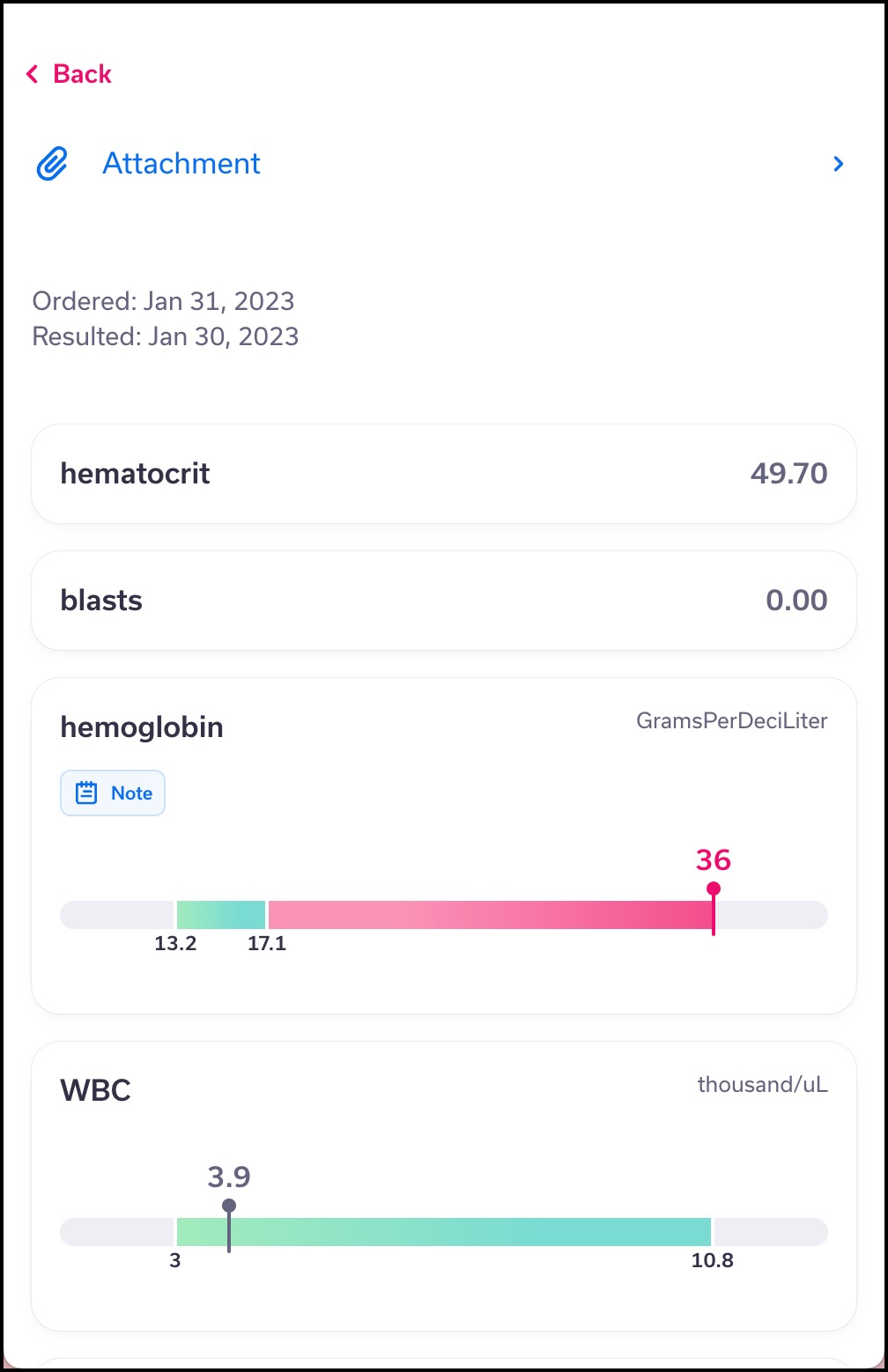
How it Works
Ranges, statuses, and other analyte data are defined and posted by the provider in the patient’s healthcare system. This result data is imported into Tendo and displayed in a visualization format that clearly defines ranges. Ranges and their values are defined both by color gradient and number. The patient’s result displays above the graph.
Workflow
When a patient receives a notification that a new lab result has been received, the patient can open the notification to directly view the results. An example shows a blood lipid panel, which has measured various Cholesterol levels. The patient can view the range for each cholesterol measurement, and whether each result is higher or lower than the given range.
Supporting Documentation
Platform Availability: 2023-02-15 | iOS 2023.6.0
Enhancements
Unless otherwise noted, all changes to the Tendo App are also available in Tendo for iOS.
Features that only include updates for Tendo for iOS were previously made available in a previous release in the Tendo App.
Care History
Imaging Reports
Imaging results are only displayed in the app after they have been reviewed by your provider. This change removes uncertainty about image results before they are reviewed by your provider. Once reviewed, the app displays the image result and any notes by your provider.
Supporting Documentation
Platform Availability: 2022-11-11 | iOS 2022.47.0
Test Analyte Notes
Providers may include notes about a specific analyte, which display below the analyte information. An analyte is the substance being measured as part of a lab result.

Supporting Documentation
Platform Availability: 2022-11-17 | iOS 2022.47.0
Notifications
Read and Unread Actions (iOS Only)
Notifications in the Notifications list can be manually marked as read or unread. This change allows patients to manage notifications. Notifications are marked as read by default when a message is viewed.
Notifications can be marked as read or unread by swiping the notification to the right [1] and tapping the Read or Unread button, respectively [2].

Supporting Documentation
Platform Availability: iOS 2022.47.0
Onboarding
HIPAA Consent Representative (Web Only)
For first-time registrants in the app, the HIPAA consent page includes an option to enter the name of an authorized representative, which has been minimized behind a drop-down menu.

Supporting Documentation
Platform Availability: 2022-11-11 | iOS 2022.47.0
Visit Summary
Appointment Provider
When applicable, Visit Summaries include the name of the provider who assisted a patient during the appointment. This provider may be different from the originally scheduled provider. For instance, this change facilitates documentation for a visit that was scheduled with a doctor but the appointment was conducted by a physician assistant.
Note: This change resolves a known issue where provider notes in the Care History page displayed the name of the scheduled provider.
Supporting Documentation
Platform Availability: 2022-11-11 | iOS 2022.47.0